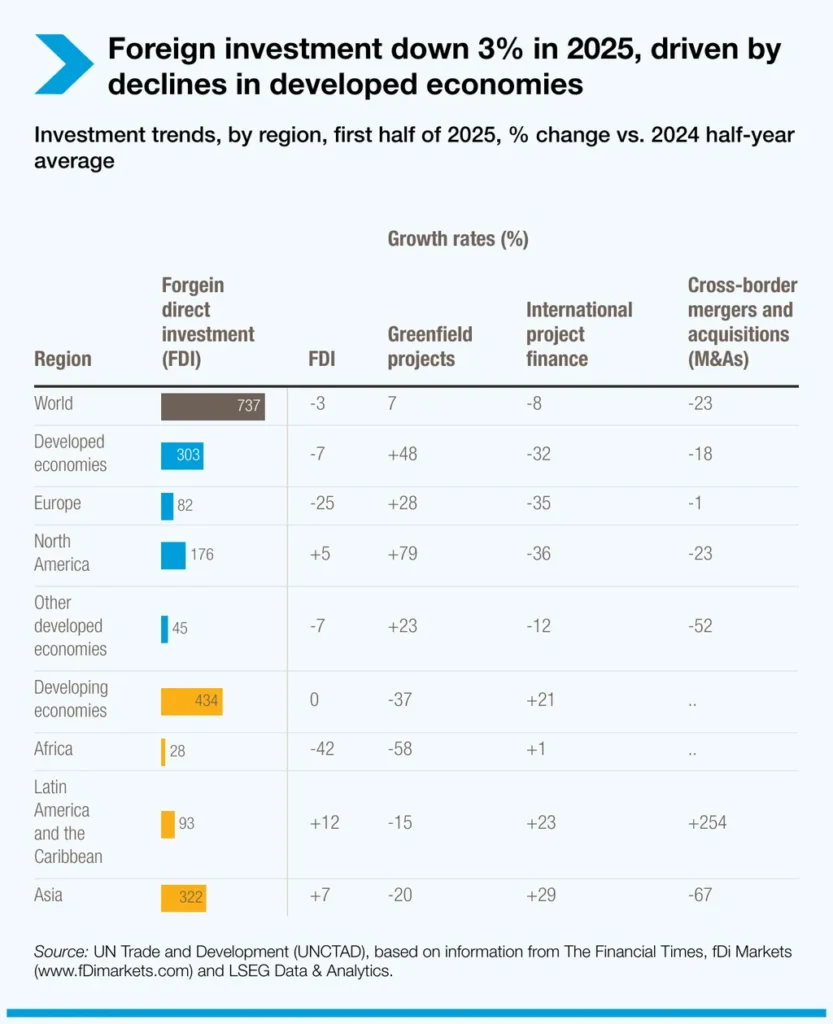Global investment flows are facing a complex and challenging landscape in 2025, with trade tensions, geopolitical risks, and supply-chain de-risking efforts continuing to cast a long shadow. The latest data from UN Trade and Development (UNCTAD) reveals a 3% decline in global foreign direct investment (FDI) in the first half of the year, extending a two-year slump. This trend is driven by a significant drop in cross-border mergers and acquisitions (M&As) in developed economies, which fell 18% to $173 billion. Meanwhile, developing economies have shown more resilience, with flows remaining flat overall, though regional trends diverge sharply.
The data underscores the growing fragmentation of global investment flows. While Latin America and the Caribbean saw a 12% rise in inflows, and developing countries in Asia experienced a 7% increase, Africa faced a steep 42% decline. This divergence suggests that investors are increasingly making decisions based on regional stability, economic policies, and geopolitical considerations rather than broad global trends.
High borrowing costs and economic uncertainty have particularly squeezed investment in industry and infrastructure. Announcements of greenfield projects—where firms build new operations abroad—fell 17%, driven by a 29% decline in supply-chain-intensive manufacturing sectors like textiles, electronics, and automotives. Tariff uncertainty and trade tensions are likely contributing to this caution, as companies hesitate to commit to long-term investments in these sectors.
International project finance, critical for infrastructure development, also declined, with deal numbers down 11% and value 8%. However, developing economies showed a more positive trend, with project finance deals falling only 2% after two years of sharp declines. The total value of these deals jumped 21%, lifted by large-scale projects in Panama, the United Arab Emirates, and Uzbekistan. This suggests that while the overall investment climate remains challenging, strategic projects in key regions are still attracting capital.
A notable bright spot is the surge in investment in artificial intelligence (AI) and the digital economy. Despite fewer projects overall, the value of global greenfield investment rose 7%, driven by major AI-related projects in the United States. The U.S. recorded $237 billion in new greenfield projects in the first half of 2025, with more than half of the value coming from AI-related sectors, particularly semiconductors and data centers. This trend highlights the growing importance of technology and digital infrastructure in global investment strategies.
However, the outlook for sustainable development investment is less promising. Investment in sectors critical to the Sustainable Development Goals (SDGs) continued to fall in early 2025. SDG-related investment projects in developing countries were down 10% in number and 7% in value, following steep declines last year. Projects in Least Developed Countries (LDCs) are on track to fall another 5% in 2025, possibly hitting their lowest level since 2015. Investment in infrastructure remained weak in developing economies, with internationally financed projects—including in transport and utilities—remaining about 25% below the decade average. In LDCs, project finance in infrastructure fell another 85% in value.
Renewable energy investment, the largest SDG-relevant sector, also weakened. Globally, international project finance in the sector fell another 9% in number and 10% in value. Greenfield projects in renewable energy declined 55% in number and 21% in value. In developing economies, projects fell 23%, and in LDCs, they declined by 31% in number and 18% in value. Investment in water and sanitation fell 40%, with no new projects in Africa or LDCs and a 97% decrease in Latin America and the Caribbean. Only agrifood systems and health showed positive trends in developing economies, with investment holding steady in agrifood and rising 37% in health, driven primarily by new projects in Asia.
The global investment climate will remain challenging through the rest of 2025. Geopolitical tensions, regional conflicts, economic fragmentation, and efforts to de-risk supply chains continue to weigh on flows. However, easing financial conditions, rising M&A activity in the third quarter, and higher overseas spending by sovereign wealth funds could support a modest rebound by year-end.
The implications for markets are significant. The growing fragmentation of global investment flows suggests that investors are increasingly prioritizing regional stability and geopolitical considerations. This could lead to a more fragmented global economy, with different regions developing their own supply chains and investment strategies. The surge in AI and digital economy investment highlights the growing importance of technology in driving economic growth and innovation. However, the decline in sustainable development investment raises concerns about the ability of developing economies to meet their SD

